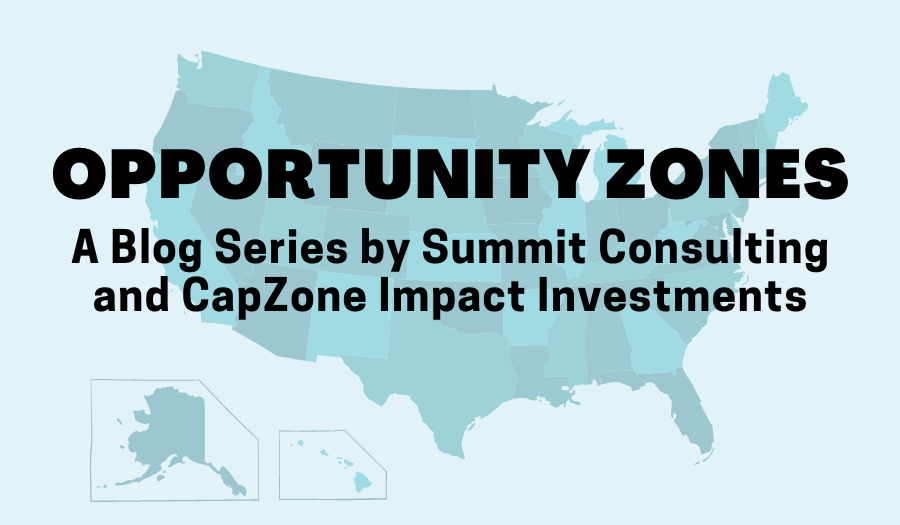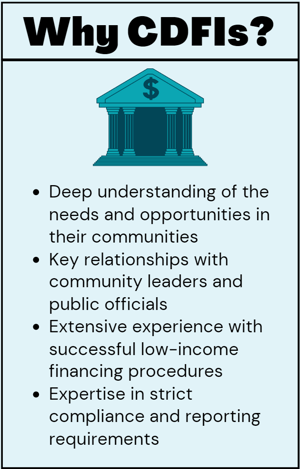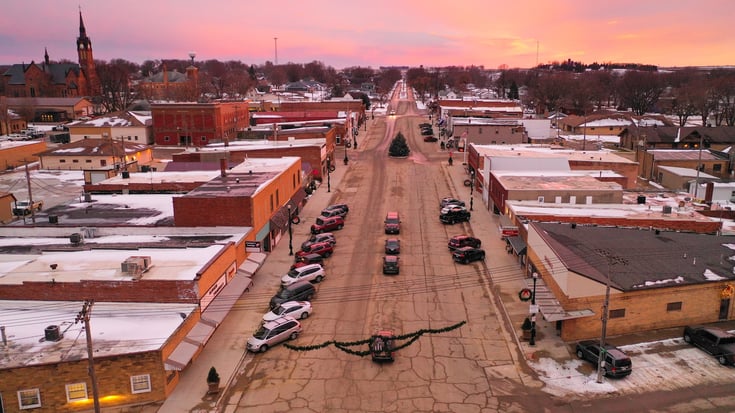Opportunities for CDFIs to Support the Growing Opportunity Zone Market
September 28, 2023 •Tony Violante

With contributions by Auyon Rahman of Summit Consulting and Jonathan Ewert of CapZone Impact Investments
Disclaimer: Summit Consulting does not provide any services directly to community development financial institutions but provides consulting and analytical support to the U.S. Department of the Treasury to measure the success of CDFI Fund programs, including the Bond Guarantee Program.
Recent Activity in Opportunity Zones
In recent months, Opportunity Zones (OZs) have received significant congressional attention through two new bills: the Rural Opportunity Zone and Investment Act (ROZIA) and the Opportunity Zones Enhancement Act of 2023 (OZEA).
- The ROZIA bill, part of the Small Business Jobs Act, would expand OZ eligibility to 1,926 census tracts where a minimum of 50% of the census blocks are designated as rural and exhibit persistent poverty levels of 20% or greater over the previous 30-year period. The ROZIA bill also includes many of the reporting requirements from the Opportunity Zones Transparency, Extension, and Improvement Act, which was introduced to Congress in April 2022 but failed to pass.
- The OZEA bill, introduced in June 2023, encourages banks to increase investment in OZ communities through tax incentives and allows OZ investments to fulfill Community Reinvestment Act requirements.
This legislative activity indicates a push for expanded OZ investment opportunities, and the level of interest in OZs is reflected in the size of the market itself.
In March 2023, Novogradac reported that $9.68 billion in equity investments was made in 2022 alone to Novogradac’s pool of tracked Qualified Opportunity Funds (QOFs), with a cumulative total of $34.09 billion since the program’s inception. Because Novogradac relies on data from publicly available sources and voluntary information, the reported figures do not include private funds—and the estimated total size of the OZ market is likely three to four times larger.
While the total size of the market is difficult to ascertain, recent estimates vary from $75 billion to $200 billion at the end of the 2022 fiscal year. A recent report by the Economic Innovation Group, which analyzed research surrounding OZs, found that total OZ investment (1) reached at least $48 billion by the end of the 2020 fiscal year and (2) reached approximately 3,800 qualified low-income communities within two and a half years. This geographic reach took the New Markets Tax Credit program 18 years to achieve.
The recent activity from Congress and investors demonstrates substantial interest in OZs. However, there has been little discussion regarding the role of community stakeholders in areas impacted by these incentives or other opportunities that exist to support this fast-growing and far-reaching investment initiative.
Novogradac reported that $9.98 billion in equity investments was made in 2022 alone [...] with a cumulative total of $34.09 billion. […] The estimated total size of the OZ market is likely three to four times larger.
 Photo by Scott Webb on Unsplash
Photo by Scott Webb on Unsplash
The Role of CDFIs in Opportunity Zones
In a previous post, Summit discussed the potential role of CDFIs in the OZ investment market. These institutions have long served many of the same communities that the OZ program is intended to support by providing access to affordable debt in low-income areas where access to capital is constrained.
As of FYE 2022, there are 1,380 CDFIs certified by the Treasury that manage approximately $247 billion in assets (primarily lending products) to support the creation of jobs, affordable housing, and financial stability in disadvantaged communities. Within the Opportunity Finance Network, an organization with 390 member CDFIs, over $100 billion in lending products were originated to support almost 700,000 businesses, develop 2.3 million housing units, and create 2.6 million jobs between 1973 and 2021. These institutions are part of a growing network that creates positive results in disadvantaged communities, which have significant overlap with communities designated as OZs.
As of FYE 2022, there are more than 1,380 CDFIs certified by the Treasury who manage approximately $247 billion in assets […] to support the creation of jobs, affordable housing, and financial stability in disadvantaged communities.
Many CDFIs have historically participated in similar tax incentive programs, including the New Markets Tax Credit program and Low-Income Housing Tax Credit program. Some CDFIs have already initiated activity in the QOF space:
- Clearinghouse CDFI is a California-based CDFI with over $2.2 billion in total lending to 3.9 million borrowers since 1996. In recent years, Clearinghouse became directly involved in the OZ market by creating the Clearinghouse CDFI Opportunity Fund, a QOF that develops and invests in real estate projects in designated Opportunity Zones across the United States.
- Local Initiatives Support Corporation is a national CDFI that has invested approximately $30 billion in underserved areas since 1979 and developed the Opportunity Zones Impact grant program in response to the creation of designated OZs. This program supports the development and implementation of community-driven strategies for investments in OZs and has provided grant funding to establish investment pipelines in OZ areas.
- Enterprise Community Investment, the parent company of the Enterprise CDFI, supported an analysis by the University of New Hampshire to identify what role CDFIs can take in supporting Opportunity Zone investments. The findings of the report are discussed in the following sections.
CDFIs can play a significant role in OZ investments, including on the front end of the investment process, during the investment period, and toward the end of a project’s life cycle.
Front-End Investment Opportunities for CDFIs
CDFIs tend to know a great deal about their communities, including the needs and investment opportunities within them.
 This expertise allows CDFIs to work with OZ investors to quickly identify qualified projects and provide related services on a fee basis. CDFIs also maintain access to information on eligible properties and businesses for OZ investment and are in an excellent position to originate these transactions. Additionally, CDFIs hold relationships with key community leaders and public officials in the areas they serve. These relationships allow CDFIs to coordinate OZ transactions with community members and identify solutions with project owners and developers.
This expertise allows CDFIs to work with OZ investors to quickly identify qualified projects and provide related services on a fee basis. CDFIs also maintain access to information on eligible properties and businesses for OZ investment and are in an excellent position to originate these transactions. Additionally, CDFIs hold relationships with key community leaders and public officials in the areas they serve. These relationships allow CDFIs to coordinate OZ transactions with community members and identify solutions with project owners and developers.
Further, CDFIs have extensive experience in conducting due diligence, servicing loans, and monitoring projects and portfolios as part of their core operations, with a long history of successful portfolio performance in areas of high credit risk. These services are subject to oversight from the U.S. Treasury Department, are available to OZ investors, and can improve the investment quality of businesses within OZs. This improved investment quality can subsequently attract more equity to new business development within OZs.
These roles demonstrate the untapped potential of the CDFI ecosystem on the front end of OZ investments. However, CDFIs can also provide substantial support during the investment period.
The Role of CDFIs During the Investment Period
One of the core components of CDFI operations is monitoring and managing high-credit-risk portfolios, including ensuring projects and borrowers maintain financial stability within established boundaries. These boundaries indicate whether an intervention may be necessary to secure a given loan or project, thus providing investors with an additional level of security to QOFs.
CDFIs also adhere to strict compliance and reporting requirements, which are subject to Treasury oversight and are invaluable to QOFs, as transparency and accurate reporting requirements would increase as soon as the Small Business Jobs Act is passed.
Additionally, the IRS recently announced a coordinated enforcement strategy (including the use of AI technology) to increase scrutiny of partnerships and high-wealth taxpayers. In a previous article, we discussed issues with reporting and compliance from QOFs. While government agencies are addressing many of these issues, the infrastructure and procedures that CDFIs use for compliance and reporting help mitigate these risks and enable further security for investors.
Last, while OZ investments are equity-based by design, OZ project investment stacks can also benefit from the below-market debt that CDFIs can provide to fill in for any financing gaps. There are also exceptions that allow QOFs to use debt financing, but certain requirements must be met for QOF loans to qualify for tax credits.
CDFIs can serve as trusted partners for any recapitalization needs of QOFs. Many CDFIs may also support federal or state grant applications that assist with project development. As projects approach the end of their life cycle, partner CDFIs can serve as institutional investor references for the purchase and sale of OZ projects.
 Photo by Josh Berendes on Unsplash
Photo by Josh Berendes on Unsplash
Additional Opportunities in the Rapidly Developing Market
The recommendations of the University of New Hampshire report (and the current CDFI activity within the OZ space) indicate that CDFIs are in an excellent position to take on a more active role in QOFs in a variety of capacities. There are multiple areas in the OZ space that CDFIs are well suited to support.
One opportunity is the availability of data surrounding OZ investments. Certain companies like Novogradac receive data from a select pool of volunteer QOFs, but the OZ market can benefit from additional data collection and reporting capabilities. CDFIs can provide robust data on investments in designated OZs, similar to past support with low-income communities, providing U.S. agencies and investors with accurate information on the level of investment in each designated OZ.
Another opportunity is tracking the level of impact created by OZ investments. A recent report by the Economic Innovation Group found that OZ investment is reaching the intended target communities that experience some of the highest levels of poverty (87th percentile) and unemployment (80th percentile) in the nation. Since the mission of CDFIs is to create positive results in distressed communities, these institutions collect substantial amounts of data on key impact metrics. The involvement of CDFIs would add to the quality and availability of impact data. The Treasury can use these data in reporting to Congress and investors can use the data to determine where to place their funding for the greatest positive effect.
Already, the OZ program has attracted significant investment and reached a substantial amount of low-income communities quicker than previous tax incentive programs. By OZ designation alone, the monthly probability of attracting investments for new commercial and residential development increased by 20% and improved median housing values by 3.4% between 2017 and 2020. Further, OZ designation has led to an average increase in city-wide development of 2.7%. The OZ program demonstrates rapid success toward its goals. With recent activity from investors and the legislature, the program will continue to grow in market size and geographic reach.
The CDFI ecosystem is naturally positioned to support investments in this program and provide an untapped institutional knowledge and infrastructure for a variety of opportunities that help both OZ investors and the low-income communities that CDFIs were created to serve.
Summit and CapZone will continue to monitor the OZ space for updates and will follow up with another blog post to capture any developments in both the CDFI space and the OZ market.
Get Updates
Featured Articles
Categories
- affordable housing (12)
- agile (3)
- AI (4)
- budget (3)
- change management (1)
- climate resilience (5)
- cloud computing (2)
- company announcements (15)
- consumer protection (3)
- COVID-19 (7)
- data analytics (82)
- data science (1)
- executive branch (4)
- fair lending (13)
- federal credit (36)
- federal finance (7)
- federal loans (7)
- federal register (2)
- financial institutions (1)
- Form 5500 (5)
- grants (1)
- healthcare (17)
- impact investing (12)
- infrastructure (13)
- LIBOR (4)
- litigation (8)
- machine learning (2)
- mechanical turk (3)
- mission-oriented finance (7)
- modeling (9)
- mortgage finance (10)
- office culture (26)
- opioid crisis (5)
- Opportunity Finance Network (4)
- opportunity zones (12)
- partnership (15)
- pay equity (5)
- predictive analytics (15)
- press coverage (3)
- program and business modernization (7)
- program evaluation (29)
- racial and social justice (8)
- real estate (2)
- risk management (10)
- rural communities (9)
- series - loan monitoring and AI (4)
- series - transforming federal lending (3)
- strength in numbers series (9)
- summer interns (7)
- taxes (7)
- thought leadership (4)
- white paper (15)


